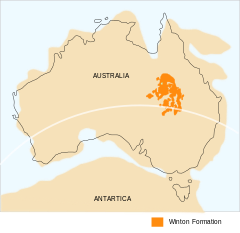| Winton Formation | |
|---|---|
| Stratigraphic range: Late Albian-Early Turonian ~ | |
 | |
| Type | Geological formation |
| Unit of | Rolling Downs Group |
| Underlies | Unconformity with Quaternary Lake Eyre Basin sediments |
| Overlies | Mackunda Formation,[1] Oodndatta Formation |
| Thickness | <100 m (330 ft) at the margin 1,200 m (3,900 ft) in the centre |
| Lithology | |
| Primary | Sandstone, siltstone, claystone |
| Other | Conglomerate, coal |
| Location | |
| Coordinates | 22°18′S 143°06′E / 22.3°S 143.1°E |
| Approximate paleocoordinates | 51°48′S 134°06′E / 51.8°S 134.1°E |
| Region | |
| Country | |
| Extent | Eromanga Basin |
| Type section | |
| Named for | Winton, Queensland |
| Named by | Whitehouse |
| Location | Bores in and around Winton |
| Year defined | 1955 |
 Formation distribution within Australia | |
The Winton Formation is a Cretaceous geological formation in central-western Queensland, Australia. It is late Albian to early Turonian in age.[2] The formation blankets large areas of central-western Queensland. It consists of sedimentary rocks such as sandstone, siltstone and claystone. The sediments that make up these rocks represent the remnants of the river plains that filled the basin left by the Eromanga Sea - an inland sea that covered large parts of Queensland and central Australia at least four times during the Early Cretaceous period. Great meandering rivers, forest pools and swamps, creeks, lakes and coastal estuaries all left behind different types of sediment.
In some areas, the Winton Formation is over 400 metres thick. To bring with them such a huge amount of sediment, the rivers that flowed across these plains must have been comparable in size to the present-day Amazon or Mississippi rivers. As more and more sediment was brought in, the margins of the inland sea slowly contracted. By around 95 million years ago, the deposition was complete and the inland sea would never be seen again.
By virtue of its age and the environmental conditions under which the rocks it consists of were deposited, the Winton Formation represents one of the richest sources of dinosaur fossils anywhere in Australia.
- ^ "Water resources - Availability - Queensland". Archived from the original on 3 June 2011. Retrieved 1 May 2011.
- ^ Tucker, Ryan T.; Roberts, Eric M.; Hu, Yi; Kemp, Anthony I.S.; Salisbury, Steven W. (September 2013). "Detrital zircon age constraints for the Winton Formation, Queensland: Contextualizing Australia's Late Cretaceous dinosaur faunas". Gondwana Research. 24 (2): 767–779. Bibcode:2013GondR..24..767T. doi:10.1016/j.gr.2012.12.009. ISSN 1342-937X.